Wow, Charles did a good job, I can see. That's a nice empire. I imagine France isn't too happy, though...
Modern Imperial History: 1547-Present
- Thread starter unmerged(87106)
- Start date
-
We have updated our Community Code of Conduct. Please read through the new rules for the forum that are an integral part of Paradox Interactive’s User Agreement.
You are using an out of date browser. It may not display this or other websites correctly.
You should upgrade or use an alternative browser.
You should upgrade or use an alternative browser.
Sorry Mr. D for being late to your class. Just heard you give another history class may I attend?
I am just reading Karl V's biography so it is interesting to see an AAR on this great leader.
I would just like to add that despite the fact that Karl is traditionally viewed as an opressor, nobody ever tries to understand the motivations behind his actions.
He fought the reformation because he did not want to see a fractured and warring Europe. He wanted to see a strong Christian world united against outside - Ottoman - threats.
He did not want genocide in the new world, he did many things to try to bring the natives to the European level, he believed that he would make their life better.
He divided his lands between his relatives before his death because he did not wish to opress Europe, he wanted to unite it. So he did not wish to see Spain ruled from Wien etc.
I really believe it was one of the greatest rulers, one that was ahead of his time in his ideals.
I would just like to add that despite the fact that Karl is traditionally viewed as an opressor, nobody ever tries to understand the motivations behind his actions.
He fought the reformation because he did not want to see a fractured and warring Europe. He wanted to see a strong Christian world united against outside - Ottoman - threats.
He did not want genocide in the new world, he did many things to try to bring the natives to the European level, he believed that he would make their life better.
He divided his lands between his relatives before his death because he did not wish to opress Europe, he wanted to unite it. So he did not wish to see Spain ruled from Wien etc.
I really believe it was one of the greatest rulers, one that was ahead of his time in his ideals.
One thing that bugs me about EU 3 is the fact that during Charles V's reign there isn't a political union between Austria and Spain.
Charles the Great indeed, if he centralised the Empire in one generation and got the Spanish to support a war in Germany. Incidentally, did he declare a new capital, or did he commute from Vienna to Madrid? I seem to remember that historically Charles was mostly based in Spain (where he faced significatn opposition, at least at the start), and that was why he mostly left Austria to his brother and never really got to grips with northern Germany.
Charles the Great indeed, if he centralised the Empire in one generation and got the Spanish to support a war in Germany. Incidentally, did he declare a new capital, or did he commute from Vienna to Madrid? I seem to remember that historically Charles was mostly based in Spain (where he faced significatn opposition, at least at the start), and that was why he mostly left Austria to his brother and never really got to grips with northern Germany.
Uhm, I don't think there was a thing like a capital. There were several kingdoms, each one had its own capital. Besides the real capital was where Charles V was
Charles the Great indeed, if he centralised the Empire in one generation and got the Spanish to support a war in Germany. Incidentally, did he declare a new capital, or did he commute from Vienna to Madrid? I seem to remember that historically Charles was mostly based in Spain (where he faced significatn opposition, at least at the start), and that was why he mostly left Austria to his brother and never really got to grips with northern Germany.
He had one of the most itinerant courts Europe ever saw, he toured more than Kylie! He was often in Spain, but not so much for love, rather to ask for support, money and men to fight his wars... He left Austria to his brother because he finally realised it was impossible to reconcile the HRE with the rest of his possesions, he didn't want his son to carry the same burden.
Philip I: 1558-1598
OK, today we're going to talk about the reign of one of my favorite Emperors, a leader who was arguably as important as Charles V, and that would be his son: Philip I. I also added some more pictures to the slides, so I can keep the attention span of you brats.
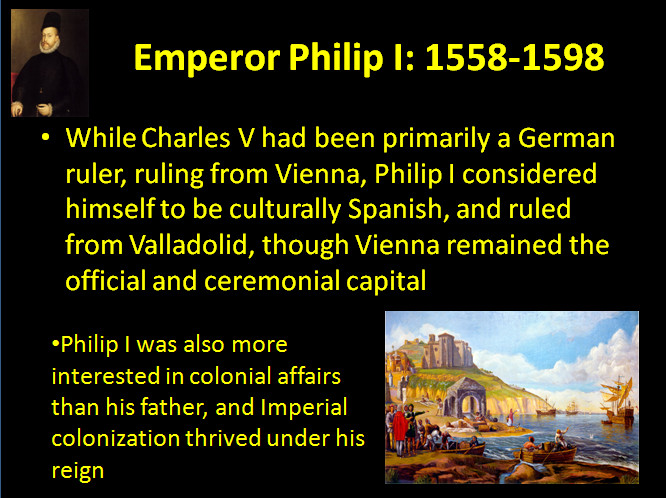
Just to start off, Philip I was born in Spain, and spent a lot of his early childhood there. When the Lutheran War began, Charles V sent Philip I to Spain, to wait in safety. It was there that Philip I learned Spanish and became fascinated with Spanish culture. This is why, during his reign, Philip I often considered himself culturally Spanish and ruled from Vallodolid, and later El Escorial. However, the imperial capital still remained Vienna, and it was from here that important ceremonial decisions were still made. Philip I also supported a more active role in colonization, and helped fund further colonization of the New World, as well as the establishment of ports across India and East Asia.

During Philip I's reign, the Empire entered an economic and cultural golden age. The arts were encouraged, and as a result flourished. Wealth, obtained from the trading of gold, silver, and spices, flowed into the Empire, turning it into a rich, economic powerhouse. And, as said before, some of this money went on to fund the great palace of El Escorial, where Philip I spent much of his reign, and where he died and was buried.
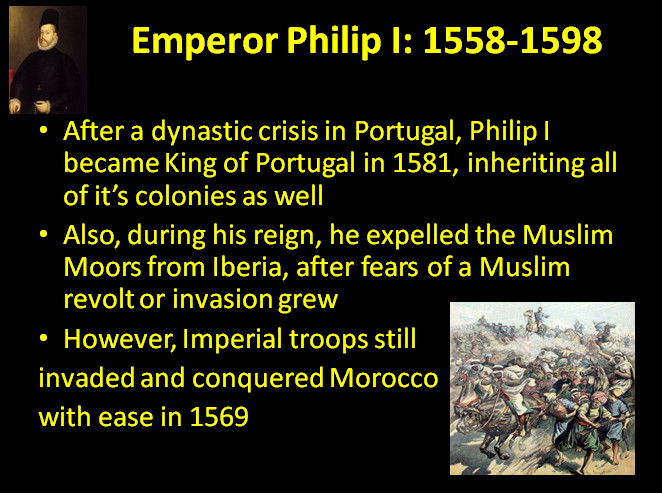
In 1581, after Portugal had a major dynastic crisis, in which many nobles were killed, Philip I became King of Portugal, bringing that nation and it's colonies into the Empire for the time being. Also, as fear of a Muslim revolt grew, Philip I was forced to exile all the Moors that remained in Spain, even though some were Christians. But this did not ease tensions with Muslim Morocco, and Philip I ordered the invasion of that nation in 1569. The backwards Moroccans were easily conquered, and forced to cede the northern half of their nation to the Empire, driving them back into the desert.
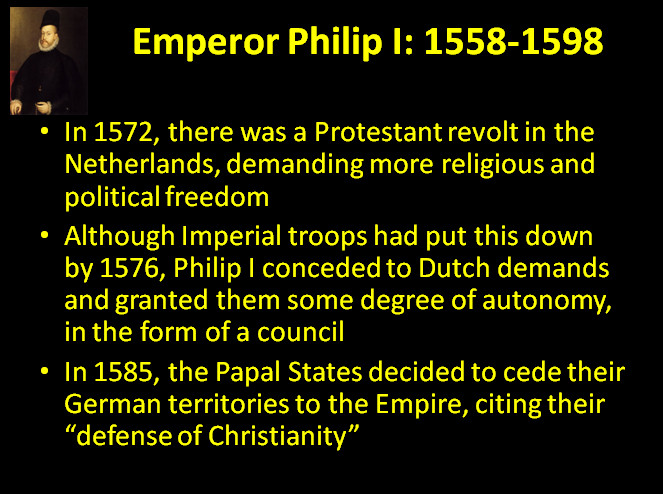
In 1572, the Protestant Dutch of the Netherlands revolted against Imperial rule, even though they had been granted religious freedom by Charles V. However, this revolt was mainly a political and cultural one. But the rebellion could never gain enough support, due to the fact that many Dutch stayed loyal to the Empire, citing Charles V's toleration. So, by 1576, Imperial troops had defeated the rebels, but Philip I still granted the Dutch some degree of autonomy, allowing the formation of local councils that would decide some laws independently of Imperial authority. And in 1585, the Papal States ceded their territories in Germany to the Empire, citing the Empire's defense of Christianity.

One of the most famous events in Philip I's reign was the victory that the Imperial Armada had over the then Protestant England in 1588. Elizabeth I, a Protestant monarch, was threatening to have the legitimate Catholic Mary, Queen of Scots executed. However, Mary was able to escape to Scotland and hide there. Even though the execution never took place, Philip I was insulted by Elizabeth I's Protestantism enough to send a massive fleet, supported by the Pope, to force Elizabeth I off the throne. The fleet sailed on calm seas to England and easily defeated the unprepared English. The fleet then disembarked, and force marched it's way to London, where it literally walked into the city without a fight. Elizabeth I fled, but was captured and beheaded. Mary, Queen of Scots came out of hiding, but conceded rule to her son, James I. Philip I sailed to London to crown James I as a Catholic King of Great Britain.
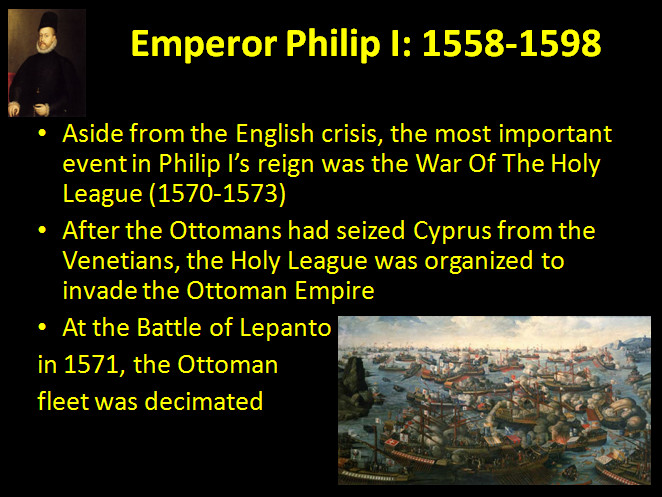
Despite this victory over, and conversion of, an entire kingdom, the Imperial Armada was not the most important event in Philip I's reign. It was in fact, the War Of The Holy League, which lasted from 1570 to 1573. Just as a little background, the Ottomans had captured Cyprus from the Venetians, and this was the justification for the war. But Europe as a whole had been afraid of the Ottoman's rising power and saw this as a chance to weaken them. So a League of Catholic nations assembled a great fleet and defeated the Ottomans at Lepanto.
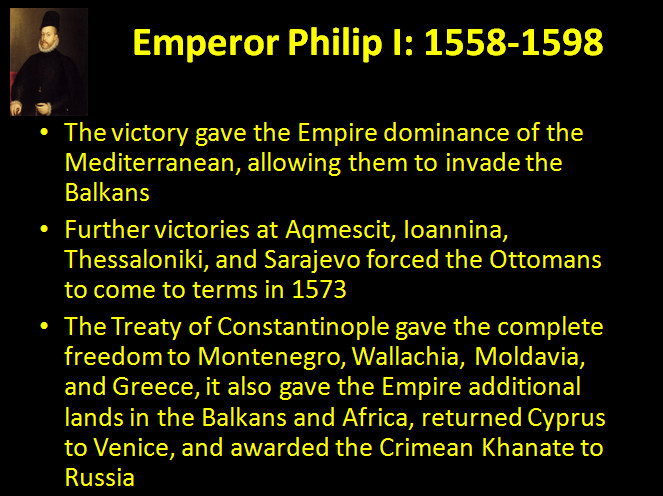
The Empire quickly capitalized on this elimination of the Ottoman navy. They invaded the Balkans across the land, and landed troops in Greece amphibiously. Victories across the Balkans and the Crimea forced the Ottomans to come to terms. It should also be noted that at this time, Mesopotamia was being invaded by Persia, with whom the Empire had relations with since Charles V formed the beginnings of an alliance with. This two front invasion was probably coordinated by both nations. Nevertheless, the Ottomans had to come to terms in the Treaty of Constantinople in 1573. As Imperial troops were just miles form the capital itself, the Ottoman sultan was forced to give complete independence to Wallachia, Moldavia, Greece, hand over much of northern Africa and the Balkans to the Empire, and give the Crimean Khanate to Russia.

Philip I died in 1598 and was succeeded by his son, Philip II. This map shows the world upon Philip I's death in 1598. If you look closely, you can see Imperial ports all across the coasts of Africa and India. So, today we learned all about how Philip I managed wars throughout his reign, even while a golden age was taking place in the Empire. The Empire had become rich enough to handle all these conflicts. Though these conquests may seem like lucky victories, we have to consider that many of them were against technologically unadvanced opponents. Nevertheless, under Philip I's, the Empire expanded even more than it did under Charles V, and Philip I's reign ushered in the golden age of the Empire.
OK, today we're going to talk about the reign of one of my favorite Emperors, a leader who was arguably as important as Charles V, and that would be his son: Philip I. I also added some more pictures to the slides, so I can keep the attention span of you brats.

Just to start off, Philip I was born in Spain, and spent a lot of his early childhood there. When the Lutheran War began, Charles V sent Philip I to Spain, to wait in safety. It was there that Philip I learned Spanish and became fascinated with Spanish culture. This is why, during his reign, Philip I often considered himself culturally Spanish and ruled from Vallodolid, and later El Escorial. However, the imperial capital still remained Vienna, and it was from here that important ceremonial decisions were still made. Philip I also supported a more active role in colonization, and helped fund further colonization of the New World, as well as the establishment of ports across India and East Asia.

During Philip I's reign, the Empire entered an economic and cultural golden age. The arts were encouraged, and as a result flourished. Wealth, obtained from the trading of gold, silver, and spices, flowed into the Empire, turning it into a rich, economic powerhouse. And, as said before, some of this money went on to fund the great palace of El Escorial, where Philip I spent much of his reign, and where he died and was buried.

In 1581, after Portugal had a major dynastic crisis, in which many nobles were killed, Philip I became King of Portugal, bringing that nation and it's colonies into the Empire for the time being. Also, as fear of a Muslim revolt grew, Philip I was forced to exile all the Moors that remained in Spain, even though some were Christians. But this did not ease tensions with Muslim Morocco, and Philip I ordered the invasion of that nation in 1569. The backwards Moroccans were easily conquered, and forced to cede the northern half of their nation to the Empire, driving them back into the desert.

In 1572, the Protestant Dutch of the Netherlands revolted against Imperial rule, even though they had been granted religious freedom by Charles V. However, this revolt was mainly a political and cultural one. But the rebellion could never gain enough support, due to the fact that many Dutch stayed loyal to the Empire, citing Charles V's toleration. So, by 1576, Imperial troops had defeated the rebels, but Philip I still granted the Dutch some degree of autonomy, allowing the formation of local councils that would decide some laws independently of Imperial authority. And in 1585, the Papal States ceded their territories in Germany to the Empire, citing the Empire's defense of Christianity.

One of the most famous events in Philip I's reign was the victory that the Imperial Armada had over the then Protestant England in 1588. Elizabeth I, a Protestant monarch, was threatening to have the legitimate Catholic Mary, Queen of Scots executed. However, Mary was able to escape to Scotland and hide there. Even though the execution never took place, Philip I was insulted by Elizabeth I's Protestantism enough to send a massive fleet, supported by the Pope, to force Elizabeth I off the throne. The fleet sailed on calm seas to England and easily defeated the unprepared English. The fleet then disembarked, and force marched it's way to London, where it literally walked into the city without a fight. Elizabeth I fled, but was captured and beheaded. Mary, Queen of Scots came out of hiding, but conceded rule to her son, James I. Philip I sailed to London to crown James I as a Catholic King of Great Britain.

Despite this victory over, and conversion of, an entire kingdom, the Imperial Armada was not the most important event in Philip I's reign. It was in fact, the War Of The Holy League, which lasted from 1570 to 1573. Just as a little background, the Ottomans had captured Cyprus from the Venetians, and this was the justification for the war. But Europe as a whole had been afraid of the Ottoman's rising power and saw this as a chance to weaken them. So a League of Catholic nations assembled a great fleet and defeated the Ottomans at Lepanto.

The Empire quickly capitalized on this elimination of the Ottoman navy. They invaded the Balkans across the land, and landed troops in Greece amphibiously. Victories across the Balkans and the Crimea forced the Ottomans to come to terms. It should also be noted that at this time, Mesopotamia was being invaded by Persia, with whom the Empire had relations with since Charles V formed the beginnings of an alliance with. This two front invasion was probably coordinated by both nations. Nevertheless, the Ottomans had to come to terms in the Treaty of Constantinople in 1573. As Imperial troops were just miles form the capital itself, the Ottoman sultan was forced to give complete independence to Wallachia, Moldavia, Greece, hand over much of northern Africa and the Balkans to the Empire, and give the Crimean Khanate to Russia.

Philip I died in 1598 and was succeeded by his son, Philip II. This map shows the world upon Philip I's death in 1598. If you look closely, you can see Imperial ports all across the coasts of Africa and India. So, today we learned all about how Philip I managed wars throughout his reign, even while a golden age was taking place in the Empire. The Empire had become rich enough to handle all these conflicts. Though these conquests may seem like lucky victories, we have to consider that many of them were against technologically unadvanced opponents. Nevertheless, under Philip I's, the Empire expanded even more than it did under Charles V, and Philip I's reign ushered in the golden age of the Empire.
Ahh , A Habsburg AAR is always fun for me to read XD . Defeating the Dutch English and Turks are always so enjoyable for me to read 
That map is frightening 
This Imperial monster may well rule 100% of the New World and a massive slice of Africa and Asia before too long. But surely the Emperor would like to unite all Europe's Catholics under one banner?
This Imperial monster may well rule 100% of the New World and a massive slice of Africa and Asia before too long. But surely the Emperor would like to unite all Europe's Catholics under one banner?
The Imperial Empire is so large! It nearly brings a tear to my own eyes. Surely you'll contend with England, France, and the Ottomans for global domination... looking forward to more!
A great AAR so far, I love every bit of it!
A great AAR so far, I love every bit of it!
As improbable as Habsburgs taking almost all of northenr Africa may be, I'll be reading this.
Have to say this is pretty fantastic. It is well written and a joy to read. I tend not to like history book AARs but this one is very good indeed.
At the very moment I imagine a certain frenchmen by the name of Napoleon who becomes 'britains sword'[1] against the Empire/Behemoth/Leviathan/BigWhiteBlob.
That would really be a very amazing story hook.
That would really be a very amazing story hook.
This time I might actually believe you when you claim to own the game.
I actually own EU3: Complete. It just doesn't work on my vista laptop. Besides, lack of gameplay allows for faster updates and more control over the alternate history.
Philip II: 1598-1621
Alright, today we're gonna talk about the reign of Philip II. His reign is kinda boring, so just bear with me. But towards the end of the lesson, you'll find out why he was one of the worst emperors ever.
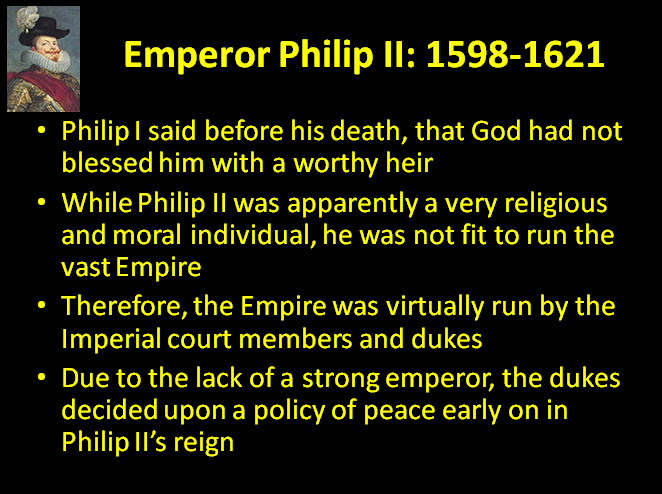
Even before Philip II was crowned, his father, Philip I said that God had not blessed him with a worthy heir. And this would prove to be very true. According to many writings from the time, we know that Philip II was a very moral and religious man. He didn't engage in many of the hedonistic court antics of the day. Now that may be admirable, but his political skill was certainly not. He left his empire to be ruled by the Spanish Duke of Lerma. The Duke effectively ruled the nation during Philip II's reign, along with many of the other Imperial court members.
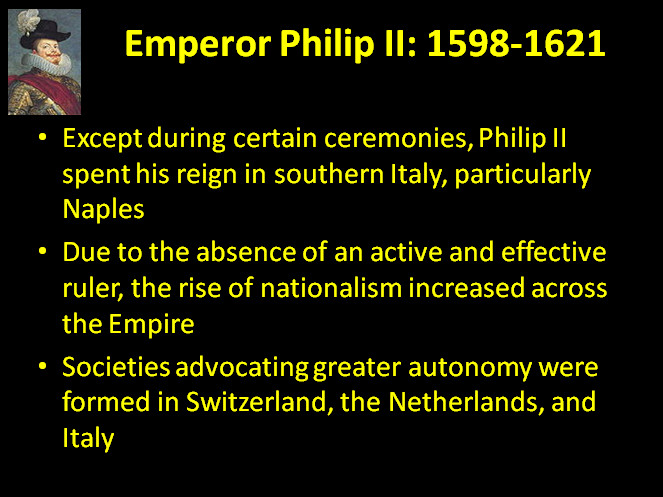
Meanwhile, much like his father, Philip II spent much of his time out of the official Imperial court. He spent his days in Naples, often traveling to and from Rome, where he would frequently attend mass and meet with the Pope. But because the Empire was left without a central figure to rally behind, unity was lost and nationalism began to rise across the Empire. Even in Germany itself, many talked of how the Spanish were taking control of the once ethnically German Empire. And this dissension is certainly understandable. Vienna, and indeed all of Germany, had not seen much of their emperors since 1558. Philip I and now Philip II spent their time in Spain or Italy, two places very different from Germany. The German people saw this as a rejection of German culture. The food, weather, landscape, everything about the Mediterranean was different than Germany. So it is no surprise when Protestantism began to once again seep out of the Netherlands and Brandenburg into other areas, like Bohemia. And many ambitious Protestants, who had fled to France, and succeeded in converting that nation, saw their chance to capitalize on this disunity in Germany and convert their homeland.
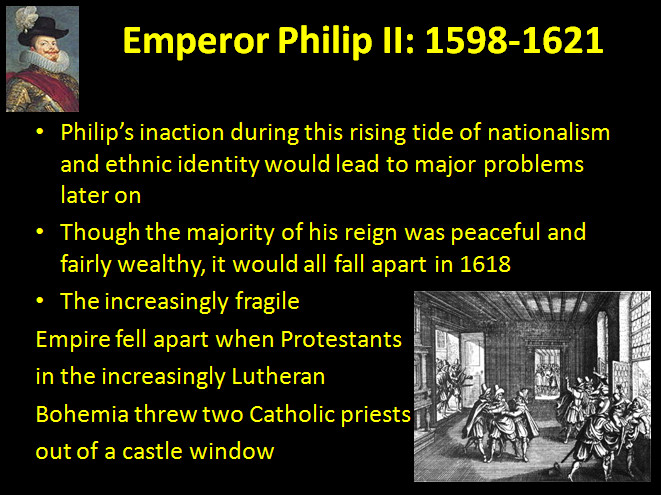
All the while, Philip II did little to nothing to stem the tide of Protestants and nationalists. Against the advice of his court, Philip II decided to actually make a decision and send Catholic missionaries to the increasingly Protestant Bohemia in 1618. This turned out to be a big mistake. The angry Bohemians, seeing this as oppression from a foreign emperor, threw two of these missionaries out of a castle window, and into a pile of manure, which actually saved the two priests lives.
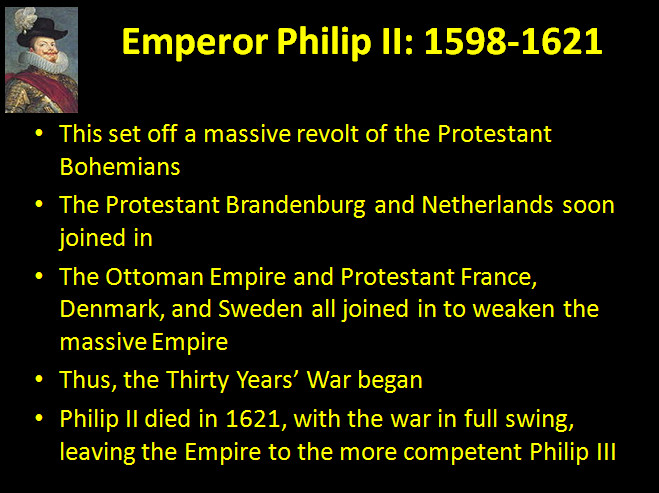
This went on to be called the "Defenestration of Prague," and ultimately began a massive Protestant revolt across Bohemia. Brandenburg and the Netherlands then joined in with this revolt against the crown. And the Protestant nations of Europe soon joined in, seeing their chance to finally weaken the Empire. This began the devastating Thirty Years' War. From 1618 to 1621, others nations merely sent supplies to the Protestant rebels, who were solidifying their position. All out chaos wouldn't occur until Philip III's reign.
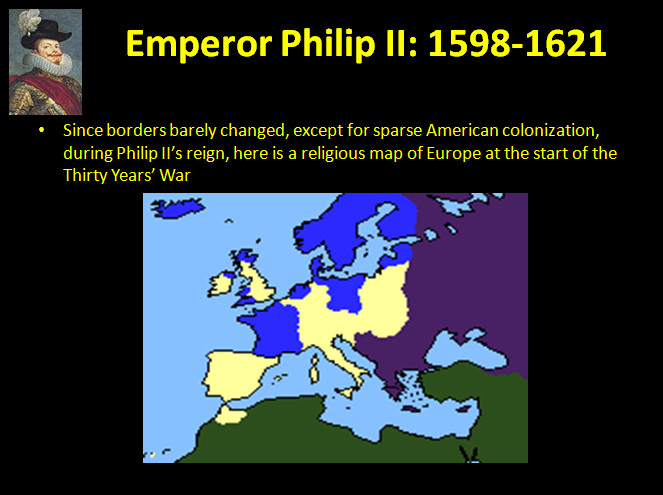
Borders around the world didn't change much during Philip II's reign, so here's a map showing the different religions across Europe upon Philip II's death in 1621. Purple is Orthodox, light yellow is Catholic, blue is Protestant, and green is Islam. But I must say, I'm not too happy with this map. It doesn't fully represent the Catholic populations that remained in southern France, as well as the rising number of Protestants in Catalonia. But overall, you can clearly see the divisions amongst Western Christianity and how they would cause conflict. Alright, that's it for today, tomorrow we'll talk about the Thirty Years' War itself, it's causes, how the Empire wasn't as strong as it seemed, and the overall reign of Philip III.
Alright, today we're gonna talk about the reign of Philip II. His reign is kinda boring, so just bear with me. But towards the end of the lesson, you'll find out why he was one of the worst emperors ever.

Even before Philip II was crowned, his father, Philip I said that God had not blessed him with a worthy heir. And this would prove to be very true. According to many writings from the time, we know that Philip II was a very moral and religious man. He didn't engage in many of the hedonistic court antics of the day. Now that may be admirable, but his political skill was certainly not. He left his empire to be ruled by the Spanish Duke of Lerma. The Duke effectively ruled the nation during Philip II's reign, along with many of the other Imperial court members.

Meanwhile, much like his father, Philip II spent much of his time out of the official Imperial court. He spent his days in Naples, often traveling to and from Rome, where he would frequently attend mass and meet with the Pope. But because the Empire was left without a central figure to rally behind, unity was lost and nationalism began to rise across the Empire. Even in Germany itself, many talked of how the Spanish were taking control of the once ethnically German Empire. And this dissension is certainly understandable. Vienna, and indeed all of Germany, had not seen much of their emperors since 1558. Philip I and now Philip II spent their time in Spain or Italy, two places very different from Germany. The German people saw this as a rejection of German culture. The food, weather, landscape, everything about the Mediterranean was different than Germany. So it is no surprise when Protestantism began to once again seep out of the Netherlands and Brandenburg into other areas, like Bohemia. And many ambitious Protestants, who had fled to France, and succeeded in converting that nation, saw their chance to capitalize on this disunity in Germany and convert their homeland.

All the while, Philip II did little to nothing to stem the tide of Protestants and nationalists. Against the advice of his court, Philip II decided to actually make a decision and send Catholic missionaries to the increasingly Protestant Bohemia in 1618. This turned out to be a big mistake. The angry Bohemians, seeing this as oppression from a foreign emperor, threw two of these missionaries out of a castle window, and into a pile of manure, which actually saved the two priests lives.

This went on to be called the "Defenestration of Prague," and ultimately began a massive Protestant revolt across Bohemia. Brandenburg and the Netherlands then joined in with this revolt against the crown. And the Protestant nations of Europe soon joined in, seeing their chance to finally weaken the Empire. This began the devastating Thirty Years' War. From 1618 to 1621, others nations merely sent supplies to the Protestant rebels, who were solidifying their position. All out chaos wouldn't occur until Philip III's reign.

Borders around the world didn't change much during Philip II's reign, so here's a map showing the different religions across Europe upon Philip II's death in 1621. Purple is Orthodox, light yellow is Catholic, blue is Protestant, and green is Islam. But I must say, I'm not too happy with this map. It doesn't fully represent the Catholic populations that remained in southern France, as well as the rising number of Protestants in Catalonia. But overall, you can clearly see the divisions amongst Western Christianity and how they would cause conflict. Alright, that's it for today, tomorrow we'll talk about the Thirty Years' War itself, it's causes, how the Empire wasn't as strong as it seemed, and the overall reign of Philip III.

